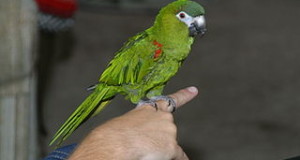 When I first began working with birds in zoo collections, older keepers warned me about respiratory ailments such as “Bird Breeder’s Lung” and “Poultry Worker’s Disease”. Several of my co-workers were always short of breath and coughed frequently. Eventually, some were diagnosed with Hypersensitivity Pneumonitis (a/k/a Extrinsic Allergic Alveolitis), which results from inhaling organic dust and other irritating substances. Private bird owners are also sometimes afflicted with this condition, and birds themselves may sicken and die when exposed to certain common airborne particles and chemicals. Unfortunately, advertisements for air-cleaning devices have confused rather than clarified the options available to us; some are actually harmful (yet still on the market!) while others are highly effective.
When I first began working with birds in zoo collections, older keepers warned me about respiratory ailments such as “Bird Breeder’s Lung” and “Poultry Worker’s Disease”. Several of my co-workers were always short of breath and coughed frequently. Eventually, some were diagnosed with Hypersensitivity Pneumonitis (a/k/a Extrinsic Allergic Alveolitis), which results from inhaling organic dust and other irritating substances. Private bird owners are also sometimes afflicted with this condition, and birds themselves may sicken and die when exposed to certain common airborne particles and chemicals. Unfortunately, advertisements for air-cleaning devices have confused rather than clarified the options available to us; some are actually harmful (yet still on the market!) while others are highly effective.
Hypersensitivity Pneumonitis
In addition to bird owners, people involved farming and certain other occupations frequently inhale substances that are harmful to the respiratory system. A slew of common names has arisen, including Mushroom Picker’s Disease, Farmer’s Lung and Air-Conditioner Lung.
Among those working with birds, Hypersensitivity Pneumonitis is most commonly seen where large collections are housed indoors with poor ventilation, or where aviaries are not cleaned on a regular basis. However, a single bird or cage can initiate health problems, especially in those who are sensitive or are afflicted with asthma.
Cockatoos and other species that produce a great deal of dander are of special concern. In addition to the fine powder these birds produce, dust from dried feces, feathers and nesting material, along with molds and fungi (please see photo), can cause lung damage. I know of several zoo-workers who have become sensitized to the dust generated by cricket colonies (raised for feeding birds); I myself now sneeze violently when near crickets in a confined area.
Acute and Chronic Forms
Acute Hypersensitivity Pneumonitis results from a single exposure to a large amount of dust or dander. A cough and flue-like symptoms, including fever, usually manifest within several hours of the incident.
Chronic Hypersensitivity Pneumonitis occurs in response to repeated, long-term inhalation of irritating particles. Over time, less and less exposure is needed to trigger injury. Permanent scarring of the lungs, known as Pulmonary Fibrosis, and other serious damage to the respiratory system may result.
Ionizers and Ozone Generators
Although marketed as being able to “scrub the air”, these appliances do not remove airborne dust to a significant degree. Both generate ozone, an unstable oxygen molecule (O3).
Ozone is an effective germicide and has a number of legitimate uses, including the treatment of waste water and exhaust gasses. However, both the Environmental Protection Agency and the American Lung Association caution against the indoor use of ozone-generating devices. In relatively small amounts, ozone has been shown to trigger asthma attacks and to reduce lung elasticity and the immune system’s ability to fight respiratory infections. Aviculturists have also linked individual and group bird deaths to ozone.
Air Purifiers
 High Efficiency Particle Arresting (HEPA) Air Purifiers are the best option for protecting the lungs of both bird and bird owner. “HEPA” is a government-established standard. In order to be so rated, the unit must remove 99.97% of those airborne particles that exceed 3 microns in size. The dander and dust typically associated with birds and other pets will be captured by a HEPA air purifier.
High Efficiency Particle Arresting (HEPA) Air Purifiers are the best option for protecting the lungs of both bird and bird owner. “HEPA” is a government-established standard. In order to be so rated, the unit must remove 99.97% of those airborne particles that exceed 3 microns in size. The dander and dust typically associated with birds and other pets will be captured by a HEPA air purifier.
Many air purifiers also utilize activated carbon to remove fumes and chemicals from the air. The fumes generated by household cleaners, burning Teflon (used to coat cookware) and similar sources are unhealthy for people and birds alike.
Please see the article below to learn more about specific HEPA Air Purifiers.
Further Reading
HEPA Air Purifiers; information and suppliers
Air Filtration; further information
Umbrella Cockatoo image referenced from wikipedia and originally posted by Wade Armstrong and Snowmanradio
Ascomycetes image referenced from wikipedia and originally posted by Dr. David Midgely
 That Bird Blog – Bird Care and History for Pet Birds
That Bird Blog – Bird Care and History for Pet Birds




hello Frank,
i got irritated eyes, and after i went to the doctor he suspects it was eye allergy caused by my new birds (java finch and budgie bought from bird market instead of breeder)…
i was prescribed with eye drop medicine, and told to stay away from the birds for a few days.
but as you know, i also have a canary. she’s been living with me for months and no problem came from her. but i am worried, could i transmit this to her?
also, if this is caused by the new bird, how do i prevent it from happening again?
i’ve kept birds before but this is the first time i got health problem…
i love birds and i don’t want to have them taken away from me just because of this…
help me Frank, i’m confused…
Hello Raymond, Frank Indiviglio here.
Sorry to hear about your difficulty. Cockatoo dander bothers many people, but I’ve not heard of what you describe. However, allergies to just about anything are possible, as my allergist told me; an allergist could test you for allergies to specific substances if you wish a definite diagnosis.
A cornea transplant many years ago has left me very sensitive to airborne dust, etc. I wear goggles when cleaning cages; cricket-holding containers are especially troublesome for me. That might help, but it would be best for you to have tests to determine the source of your problem.
No need to be concerned about making the canary ill.
Please let me know if you need any further information. Good luck and please keep me posted.
Best regards, Frank Indiviglio.